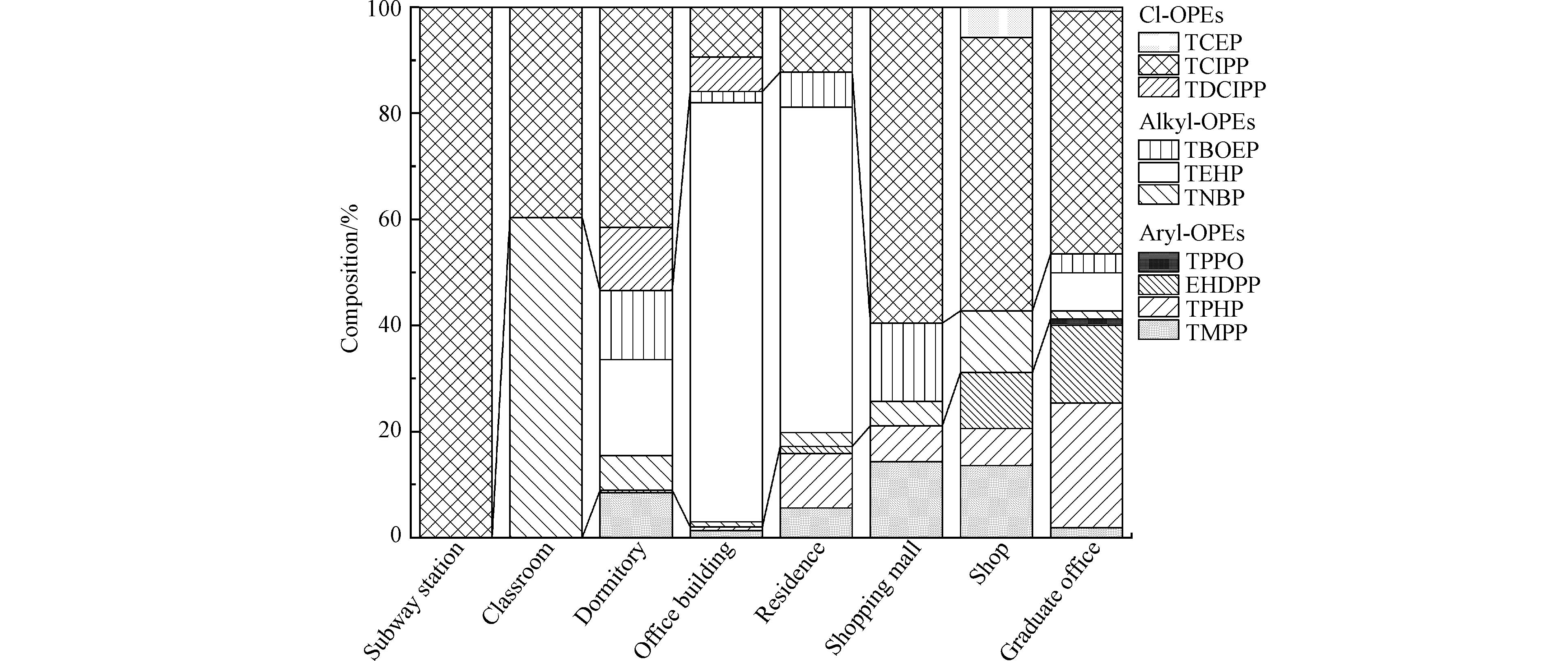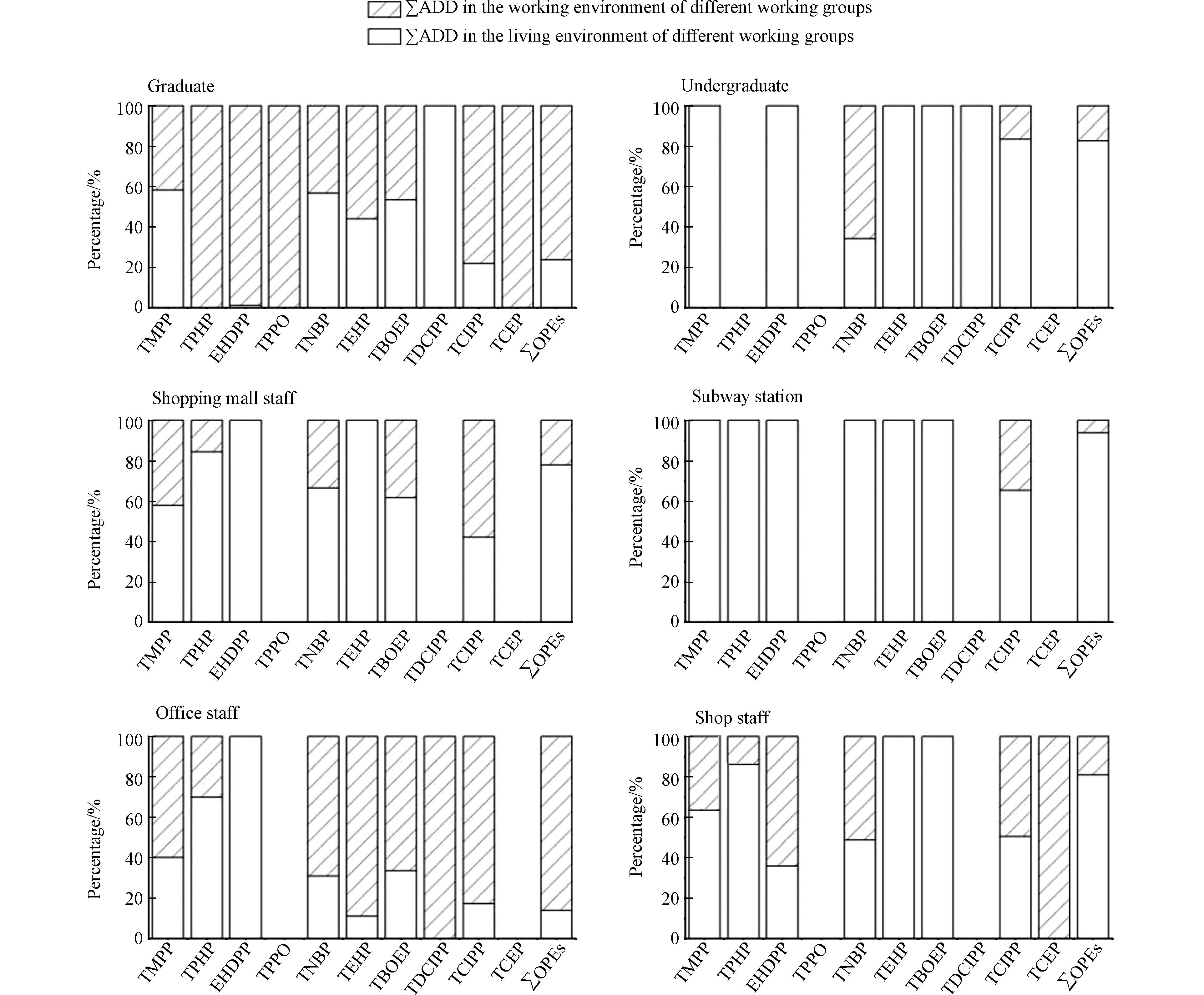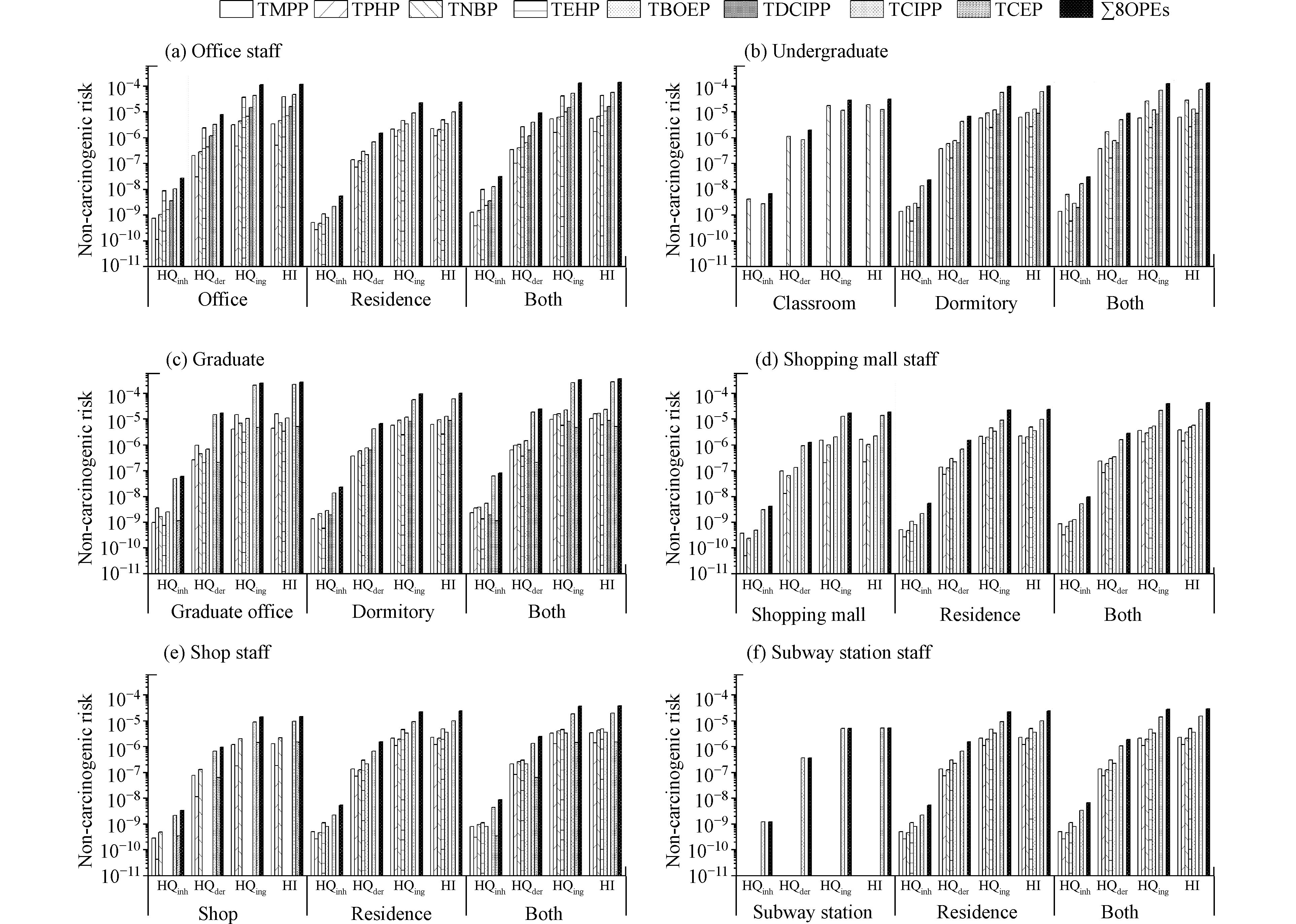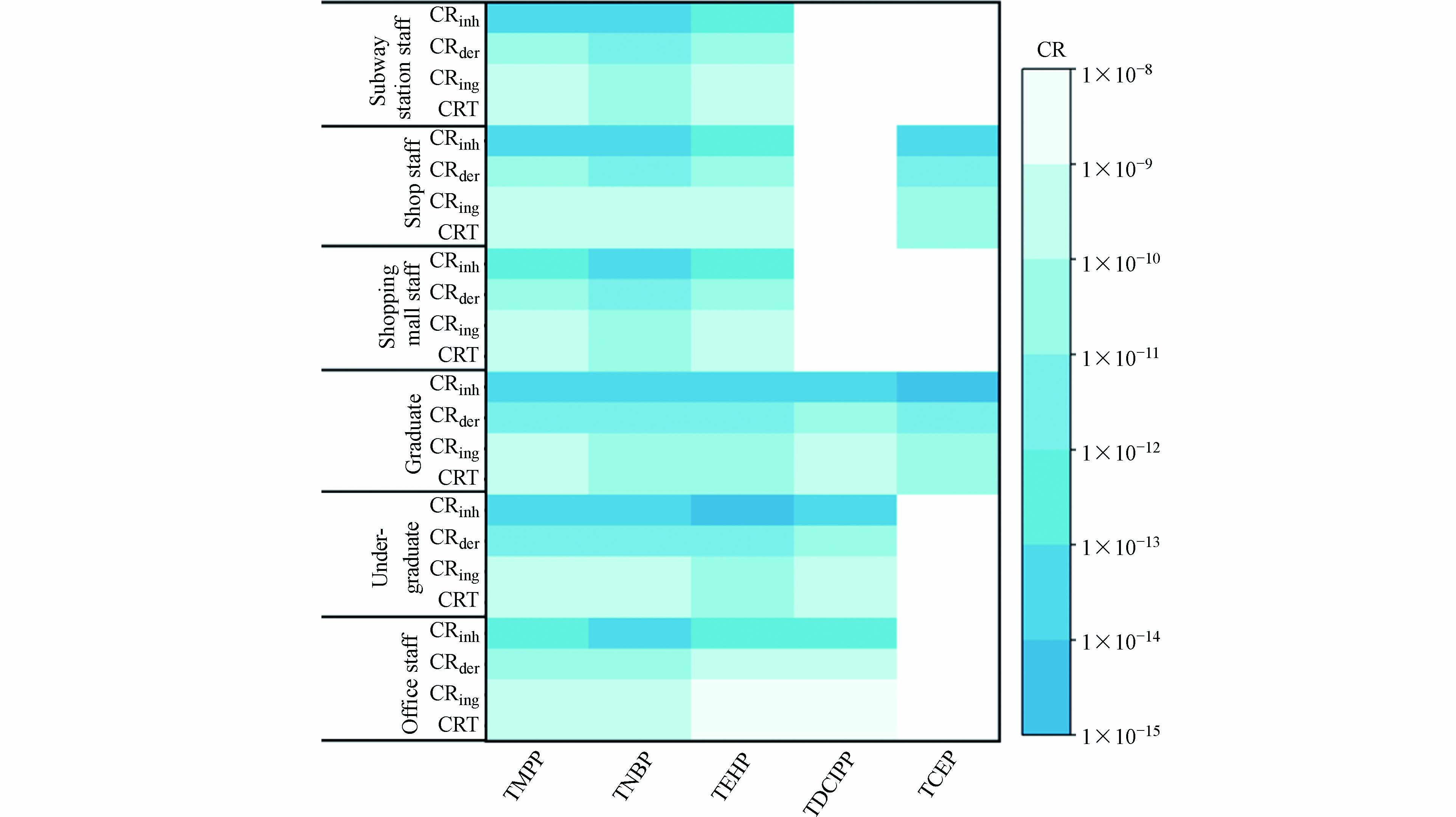-
有机磷酸酯(organophosphate esters, OPEs)主要作为阻燃剂和增塑剂被广泛生产和使用. 随着溴代阻燃剂(brominated flame retardants, BFRs)在全球范围内被逐步禁用,其主要替代品OPEs的产量大幅增加[1],被广泛用于建筑材料、电子产品、家装饰品和纺织品等行业. 由于OPEs是物理添加型阻燃剂,易经过挥发、浸出、产品使用摩损等方式释放进入环境[2],OPEs环境问题引起国内外的广泛关注. 作为一类新兴环境污染物,OPEs在全球环境中普遍存在. 目前已有大量研究表明在水体、土壤、空气和灰尘等各种环境介质中检测到OPEs[3-6]. 此外,在生物体、人体血液和尿液中也检测出了OPEs及其代谢产物[7-8]. 毒理学研究结果显示,部分OPEs会影响生物内分泌、神经系统和生殖功能,并且具有溶血作用、致畸性和潜在致癌毒性[9].
灰尘既是室内材料释放的有机污染物的首要聚集地,同时也是室外污染物进入室内后的汇,且被公认为是室内环境污染的有效指示物[10-11]. 研究证实各类微环境室内灰尘中均存在不同程度的OPEs污染,包括家庭[12-14]、办公室[15]、教室[16-17]等. 一项对中国室内灰尘中OPEs污染状况的调研显示[18],办公室和电子废物拆解车间室内灰尘OPEs的含量高于家庭、高校宿舍和其他微环境. 由于室内特殊的环境条件,如更少的阳光直射等,室内灰尘中聚积的OPEs可能比在其他环境介质中半衰期更长,因而具有更强的持留性和人群暴露机会. 室内灰尘中的OPEs可通过手口摄入、呼吸吸入和皮肤接触等途径被人体吸收[19],造成潜在的健康风险.
本研究以室内灰尘作为研究对象,在上海市高校(教室、研究生办公室和宿舍)、办公楼、公共场所(商场、街边商铺和地铁站)和家庭等8种不同微环境采集样品,探究不同微环境室内灰尘中OPEs的含量和组分特征,同时整合生活和工作/学习两类暴露场景,综合评估室内灰尘中OPEs对不同职业人群的健康风险.
-
仪器:气质谱联用仪(日本岛津公司,TQ8040 NX);固相萃取仪(美国Supelco公司);旋转蒸发仪(郑州长城科工贸有限公司,R-1001M).
试剂:9种OPEs标准品购自美国Accustandard公司,包括3种氯代烷基磷酸酯(Cl-OPEs),包括磷酸三(2-氯乙基)酯(TCEP)、磷酸三(1-氯-2-丙基)酯(TCIPP)、磷酸三(1,3-二氯-2-丙基)酯(TDCIPP);3种烷基磷酸酯(Alkyl-OPEs),包括磷酸三丁酯(TNBP)、磷酸三(2-丁氧乙基)酯(TBOEP)、磷酸三(2-乙基己酯)(TEHP),以及3种芳基磷酸酯(Aryl-OPEs),包括磷酸2-乙基己基二苯基(EHDPP)、三苯基氧磷(TPPO)、磷酸三甲基苯(TMPP). 还有1种Aryl-OPEs标准品磷酸三苯酯(TPHP)从梯希爱(上海)化成工业发展有限公司购买. 替代物内标(TCEP-d12、TCIPP-d18、TPHP-d15)和内标物六甲基苯(HMB)从英国剑桥同位素实验室购买.
-
本研究以室内灰尘作为研究对象,2021年12月在上海市高校(教室、研究生办公室和宿舍)、办公楼、公共场所(商场、街边商铺和地铁站)和家庭等8种不同微环境共采集24个样品,每种微环境各3个样品. 软毛刷经超纯水清洗烘干后再用正己烷清洗一遍,放置通风橱内晾干后装入自封袋密封备用,采样前尽量避免打开. 选用五点采样法对室内地表灰尘样品进行收集,尽量对室内地面全面采集,以便反映实际情况. 灰尘使用软毛刷采集,干净的铝箔纸包裹严实装入自封袋保存,装入低于4 ℃的保温箱尽快转移至实验室. 所有灰尘样品过 200 目不锈钢筛后,于-20 ℃的冰箱避光保存.
-
基于现有文献[20-21],优化后OPEs前处理方法如下:称取0.50(±0.0002)g灰尘样品于聚四氟乙烯离心管中,加入15 mL丙酮/正己烷(1:1,V:V)的萃取液,以及替代物内标(TPHP-d15、TCIPP-d18和TCEP-d12),常温超声20 min,并以3500 r·min−1离心7 min. 收集上清液,重复上述步骤3次.
将萃取液旋蒸至近干,加入2 mL正己烷回溶待用. 用8 mL乙酸乙酯和6 mL正己烷分别对固相萃取净化小柱进行活化,随后将萃取液转移至固相萃取小柱中. 待目标物与小柱填料充分接触后,先用10 mL正己烷进行淋洗,弃去该部分洗脱液;然后再用8 mL乙酸乙酯对小柱进行洗脱,获得目标组份. 最后将含有目标组分的乙酸乙酯溶液旋蒸至近干,定容至1 mL,过滤(0.22 μm),加入20 μL内标(10 μg·mL−1 HMB),涡旋1 min后转移到棕色色谱瓶中以备仪器分析.
-
本研究采用岛津GCMS-TQ8040 NX对样品进行检测,选择电子轰击电离(EI),色谱柱为DB-5MS(柱长30 m,内径0.25 mm,液膜厚度0.25 μm),采用SIM模式进行样品的检测. 升温程序为:起始温度为70 ℃,保留2 min,然后以15 ℃∙min−1升温至300 ℃,保留5 min. 进样口温度为300 ℃,载气为高纯氦气,柱流速为1 mL∙min−1,离子源温度为230 ℃,四极杆温度为150 ℃,辅助加热区温度为280 ℃,进样量为1 μL,不分流进样,溶剂延迟时间为7.0 min.
-
实验中设置方法空白、空白加标、基质加标及平行样对数据进行质量控制. 仪器的检出限(LOD)和定量限(LOQ)分别为0.0036—0.1091 ng·L−1和0.0119—0.3636 ng·L−1. 方法空白中目标化合物均低于LOD,对样品检测值无影响. 灰尘样品中替代物内标TCEP-d12、TCIPP-d18和TPHP-d15的回收率范围分别为82.6%—110.4%、85.5%—113.2%和80.8%—119.8%. OPEs单体的相对标准偏差(RSD)小于10%,目标化合物的回收率范围为87%—102%.
-
本研究采用美国环保署(US EPA)建立的暴露评估模型[22],结合《中国人群暴露参数手册(成人卷)》[23]及相关研究[24-26]所提供的暴露参数,评估灰尘中OPEs通过呼吸吸入、皮肤接触和手口摄入3种暴露途径对不同职业人群的暴露水平及潜在的健康风险.
-
呼吸吸入:
式中,ADDinh为呼吸吸入的日均暴露量,ng·kg−1·d−1;Cdust为灰尘中OPEs的平均含量,ng·g−1;Rinh为呼吸速率,16.3 m3·d-1[23];EF为年暴露频率,办公室工作人员、商场工作人员和街边商铺工作人员的工作/学习环境和生活环境分别取136.85 d·a−1和182.47 d·a−1,高校本科生和研究生分别取121.65 d·a−1和197.68 d·a−1,地铁工作人员分别取180 d·a−1和185 d·a-1[23];ED为暴露年限,高校本科生和研究生分别取4 a和3 a,其他职业取24 a[22];PEF为颗粒物消除因子,取1.36×109 m3·kg-1[25];BW为平均体重,63.5 kg[23];AT为平均暴露时间,a,AT非致癌风险=ED×365,AT致癌风险=average lifetime×365[23,26],其中average lifetime为平均期望寿命,80.26 a[23];CF为换算系数,取1×10−3 g·mg−1.
皮肤接触:
式中,ADDder为皮肤接触的日均暴露量,ng·kg−1·d−1;SA为皮肤接触面积,2100 cm2[23];ABS为皮肤吸收因子,0.01 mg·cm−2·d-1[24];AF为皮肤吸收比例,TCEP、TDCIPP、TCIPP分别为0.104,0.186和0.174,其他OPE单体为0.154[24].
手口摄入:
式中,ADDing为手口摄入的日均暴露量,ng·kg−1·d−1;Ring为手-口摄入速率,50 mg·d-1[23].
总日均暴露量:
式中,ΣADDW和ΣADDR分别为职业人群在工作/学习环境(教室、研究生办公室、办公楼、商场、街边商铺和地铁站)和生活环境(宿舍和家庭)中的总日均暴露量,ng·kg−1·d−1.
-
非致癌风险评价采用非致癌危害指数法,根据公式(5)和(6)计算非致癌风险商数(HQ)和非致癌危险指数(HI):
式中,ADD非致癌为3种暴露途径下OPEs日均暴露量,ng·kg−1·d−1;RfD为非致癌经口摄入参考剂量,ng·kg−1·d−1. 评价标准:HI<1,表示非致癌风险可忽略;HI≥1,表示有非致癌风险,数值越大说明风险越高.
致癌风险的评价采用致癌风险指数法,根据公式(7)和(8)计算致癌风险指数(CR):
式中,ADD致癌为3种暴露途径下OPEs终身平均日暴露量,ng·kg−1·d−1;SF为致癌斜率因子,kg·d·ng−1. 评级标准:CRT<10−6,表示致癌风险可忽略;CRT>10−6,表示有致癌风险,数值越大说明风险越高. 本研究评价了TPHP、TBOEP、TCIPP、TMPP、TNBP、TEHP、TDCIPP和TCEP的非致癌风险,TMPP、TNBP、TEHP、TDCIPP和TCEP的致癌风险. OPEs的RfD和SF参考值如表1所示.
-
上海市8类不同微环境室内灰尘中10种OPEs的检出率和含量见表2. 10种OPEs在各微环境室内灰尘中均有不同程度地检出,表明OPEs是室内环境中普遍存在的污染物. TCIPP的检出率最高为100%;其次是TNBP、TMPP、TPHP和TBOEP,检出率分别为87.5%、75%、62.5%和62.5%;EHDPP、TEHP、TDCIPP、TCEP和TPPO检出率较低,分别为50.0%、50.0%、25.0%、25.0%和12.5%.
上海市8类不同微环境室内灰尘中Σ10OPEs含量分布存在显著差异(P<0.05). 研究生办公室和办公楼灰尘中Σ10OPEs含量最高,分别为(16828±2693)ng·g−1和(15646±1534)ng·g−1,其次是宿舍((3200±541)ng·g−1)、家庭((1899±62.41) ng·g−1)和教室((1094±501) ng·g−1),与研究生办公室和办公楼相比低1个数量级;商场((713±117)ng·g−1)、街边商铺((588±28.68) ng·g−1)和地铁站((127±14.71)ng·g−1)灰尘中Σ10OPEs含量较低,与研究生办公室和办公楼相比低2个数量级.
有研究[2]表明,北京办公室(17600 ng·g−1)与本研究中研究生办公室和办公楼的含量相当. 在研究生办公室和办公楼室内灰尘中检出的OPEs含量在全球处于中等污染水平,低于发达国家英国(69730 ng·g−1)[16],高于发展中国家埃及(522 ng·g−1)[28]. 在宿舍和家庭室内灰尘中检出的OPEs含量在全球处于较低污染水平,明显低于罗马尼亚(8360 ng·g−1)[29]、德国(3000 ng·g−1)[6]和新西兰(5510 ng·g−1)[13],但在我国范围内高于南京(1340 ng·g−1)[30]. 在教室灰尘中OPEs含量在全球处于较低污染水平,远低于日本(281800 ng·g−1)[17]和英国(97820 ng·g−1)[16],与我国成都高校教室(1837 ng·g−1)[31]相比,污染水平相当. 国内外对于商场、街边商铺和地铁站的研究较少,本研究中商场和街边商铺中OPEs的含量接近于巴基斯坦商店的OPEs含量(300 ng·g−1)[32],而在我国范围内,远低于南京公共环境灰尘中的含量(12900 ng·g−1)[30].
-
就3种不同类型OPEs而言,不同微环境室内灰尘中Aryl-OPEs、Alkyl-OPEs和Cl-OPEs的占比有所差别(图1). 绝大多数微环境包括地铁站、商场、街边商铺、宿舍和研究生办公室室内灰尘中以Cl-OPEs为主,占比分别为100%、59.6%、57.2%、53.4%和46.5%;而办公楼、家庭和教室室内灰尘中以Alkyl-OPEs为主,占比分别为82.1%、70.6%和60.3%. 现有研究结果表明Cl-OPEs是室内灰尘样品中的主要污染物[33],与本研究的结果基本一致. 这主要是因为Cl-OPEs的生产量和使用量超过非Cl-OPEs,以及其在环境中持久存在[12]. 值得注意的是,Aryl-OPEs在研究生办公室灰尘中的占比为41.2%,与Cl-OPEs占比相当. Aryl-OPEs常被添加在电子设备中作为阻燃剂[34],而研究生办公室正是电子产品密集使用的场所;此外,这2类OPEs的主要化合物具有较低的蒸汽压,因此可能同样通过产品磨损进入到环境中[35]. 同样地,Aryl-OPEs和Cl-OPEs在我国成都高校办公室灰尘中也占据着主导地位,占比分别为44%和43%[31]. 此外,本研究中关于教室和家庭的研究结果与日本[17]的研究相一致,即在教室和家庭室内灰尘中Alkyl-OPEs是主要污染物,分别占Σ9OPEs的97.1%和94.1%.
就各OPEs单体而言,绝大多数微环境包括地铁站、商场、街边商铺、研究生办公室、宿舍和教室室内灰尘中TCIPP是最主要的OPEs,占比分别为100%、59.6%、51.5%、45.8%、41.5%和39.7%. TCIPP常被报道是室内灰尘中最主要的OPEs单体[10,16]. 自20世纪60年代中期,TCIPP的使用量持续增长,一方面由于TCIPP的毒性相对于TCEP较弱,逐步替代TCEP;另一方面,TCIPP因价格较低而被广泛生产并在PVC和聚氨酯泡沫等产品中广泛使用[18,34,36]. 但是与TCIPP相比,教室灰尘中TNBP的占比相对更高,为60.3%,这可能与其使用的建筑和装修材料相关. 目前已有研究已经证实TCIPP和TNBP是中国建筑和装修材料中最主要的OPEs单体[21]. 办公楼和家庭灰尘中TEHP是最主要的OPEs,占比分别为79.0%和61.4%. 这可能与TEHP在地板油、合成橡胶、PVC塑料制品(如窗户框)和漆器等产品的使用有关[37],因为TEHP不仅可用作增塑剂,也用作油漆和地板蜡中的抗发泡剂. 此外,除TCIPP外,TPHP也是研究生办公室灰尘中的一大特征污染物,这可能与TPHP在电子产品中的使用密切相关[38]. 目前已有研究证实TPHP在我国南方电子废弃物拆解厂灰尘中作为含量最高的污染物被广泛检出,占Σ8OPEs的45.0%—50.9%[39].
-
本研究评估了不同职业人群(包括高校研究生、高校本科生、办公室工作人员、商场工作人员、街边商铺工作人员和地铁工作人员)在生活和工作/学习环境中通过手口摄入、皮肤接触和呼吸摄入3种暴露途径对室内灰尘中OPEs的平均日暴露量(表3). 结果表明,ADDing>ADDder>ADDinh,且ADDing比ADDder和ADDinh的日暴露量高1—4个数量级. 手口摄入是职业人群对室内环境灰尘中OPEs的主要暴露途径,与以往的研究结果一致[15,40]. 不同职业人群暴露量从高到低排序为:高校研究生(6.18 ng·kg−1·d−1)>办公室工作人员(5.72 ng·kg−1·d−1)>高校本科生(1.77 ng·kg−1·d−1)>商场工作人员(1.02 ng·kg−1·d−1)>街边商铺工作人员(9.82×10−1 ng·kg−1·d−1)>地铁工作人员(8.61×10−1 ng·kg−1·d−1). 本研究中ADD值普遍低于其他国家室内日暴露量(埃及20.9 ng·kg−1·d-1[28]、挪威70 ng·kg−1·d-1[15]和英国785 ng·kg−1·d-1[15]),高校研究生和办公室人员的日暴露量与中国其他地区(哈尔滨5.22 ng·kg−1·d-1[24]和广州4.95—8.08 ng·kg−1·d-1[14])相当.
不同职业人群摄入OPEs的主要暴露源存在一定差异(图2). 生活环境灰尘是地铁站工作人员、高校本科生、街边商铺和商场摄入OPEs的主要暴露源,这4种职业人群对生活环境灰尘中OPEs的摄入量分别占两种环境总摄入量的93.9%、82.6%、81.1%和78.0%. 而工作/学习环境灰尘是办公室工作人员和高校研究生摄入OPEs的主要暴露源,这2种职业人群对工作/学习环境中灰尘OPEs的摄入量分别占两种环境总摄入量的86.1%和76.4%.
-
总体上(图3),各职业人群不同暴露途径的HQ值排序为:HQing > HQder > HQinh. 各类OPEs中,TCIPP是对非致癌风险的主要贡献者,TCIPP的HI比其他OPEs的HI高1—2个数量级. 6种职业人群暴露于生活和工作/学习环境室内灰尘HI值排序依次为:高校研究生(3.64×10−4)>办公室工作人员(1.41×10−4)>高校本科生(1.31×10−4)>商场工作人员(4.22×10−5)>街边商铺工作人员(3.83×10−5)>地铁站工作人员(2.93×10−5). 综上,高校研究生暴露于生活和工作/学习环境室内灰尘中OPEs的非致癌风险水平高于其他职业者,但是各种职业人群的HI值均远小于1,表明生活和工作/学习环境灰尘中OPEs对6种职业人群造成的非致癌风险可忽略.
-
总体上(图4),各职业人群不同暴露途径的CR值排序为:CRing > CRder > CRinh. 各类OPEs中,TEHP对办公室工作人员、商场工作人员、街边商铺工作人员和地铁工作人员的致癌风险更高,而对高校本科生和高校研究生具有更高风险的是TDCIPP. 6种职业人群的总致癌风险指数CRT排序依次为:办公室工作人员(8.02×10−9)>街边商铺工作人员(1.06×10−9)>商场工作人员(1.01×10−9)>地铁站工作人员(7.99×10-10)>高校本科生(5.6×10-10)>高校研究生(3.86×10-10). 所有OPEs的致癌风险CR值均比1×10−6低3—4个数量级,表明生活和工作/学习环境灰尘中OPEs对不同职业人群造成的致癌风险均在可接受的范围内.
-
(1)OPEs是上海市室内灰尘中普遍存在的环境污染物,但是不同微环境中OPEs的污染水平和组成特征存在一定差异. 研究生办公室和办公楼灰尘中OPEs的含量远高于其他室内环境. 绝大多数微环境包括地铁站、商场、街边商铺、宿舍和研究生办公室灰尘中以Cl-OPEs为主,其中TCIPP是主要污染物;在办公楼、家庭和教室中以Alkyl-OPEs为主,其中教室的主要污染物为TNBP和TCIPP,办公楼和家庭的主要污染物为TEHP.
(2)在生活和工作/学习环境中,手口摄入是人类暴露于灰尘中OPEs的主要暴露途径,但是不同职业人群摄入OPEs的主要暴露源存在一定差异,生活环境室内灰尘是商场、街边商铺和地铁站的工作人员以及高校本科生的主要暴露源;相反地,工作环境室内灰尘是办公室工作人员和高校研究生的主要暴露源.
(3)在生活和工作/学习环境中,人类暴露于灰尘中OPEs的非致癌风险和致癌风险均在可接受范围内,但是不同职业人群面临的非致癌风险和致癌风险均存在一定差异.
上海市不同微环境室内灰尘中有机磷酸酯污染特征及健康风险评价
The pollution characteristics and health risk assessment of organophosphate esters in indoor dust from different microenvironments in Shanghai
-
摘要: 作为一类新兴污染物,有机磷酸酯(OPEs)的环境污染状况及其潜在的健康风险受到国内外的广泛关注. 本研究以室内灰尘作为研究对象,在上海市高校(教室、研究生办公室和宿舍)、办公楼、公共场所(商场、街边商铺和地铁站)和家庭等8种不同微环境采集样品,利用气质联用仪(GC-MS)测定灰尘中10种OPEs(TMPP、EHDPP、TPHP、TPPO、TBOEP、TNBP、TEHP、TCIPP、TDCIPP和TCEP)的含量,并采用 US EPA 推荐的健康风险评模型,结合中国人群的暴露参数,整合生活和工作/学习两类暴露场景,综合评价室内灰尘中OPEs对不同职业人群的健康风险. 研究表明,上海市室内灰尘中OPEs的总含量范围为127—16828 ng·g−1,其中研究生办公室和办公楼灰尘中OPEs的总含量比其他微环境高1—2个数量级. 绝大多数微环境包括地铁站、商场、街边商铺、宿舍和研究生办公室灰尘中以Cl-OPEs为主,其中TCIPP是主要污染物;在办公楼、家庭和教室中以Alkyl-OPEs为主,其中教室的主要污染物为TNBP和TCIPP,办公楼和家庭的主要污染物为TEHP. 职业人群OPEs的主要暴露途径均为手口摄入,但是不同职业人群摄入OPEs的主要暴露源存在差异,生活环境室内灰尘是商场、街边商铺和地铁工作人员以及高校本科生的主要暴露源;工作/学习环境室内灰尘是办公室工作人员和高校研究生的主要暴露源. 此外,在生活和工作/学习环境中,人类暴露于灰尘中OPEs的非致癌风险和致癌风险均在可接受范围内.Abstract: As a kind of emerging pollutants, the environmental pollution status and health risks of organophosphorus esters (OPEs) have been widely concerned at home and abroad. In this study, indoor dust samples were collected from 8 different microenvironments in Shanghai, including university microenvironments (classrooms, graduate offices and dormitories), office buildings, public microenvironments (shopping malls, shops and subway stations) and houses. The concentrations of 10 OPEs (TMPP, EHDPP, TPHP, TPPO, TBOEP, TNBP, TEHP, TCIPP, TDCIPP and TCEP) were determined by GC-MS, and the health risk for different occupations exposure to OPEs in dusts of living and working/studying environments was evaluated by the health risk assessment model recommended by the US EPA combined with the exposure parameters of the Chinese population. The results showed total concentrations of OPEs in dust samples ranged from 127 ng·g−1 to 16828 ng·g−1, and the total concentrations of OPEs in dust from graduate offices and office buildings were 1—2 orders of magnitude higher than that in other microenvironments. Cl-OPEs were the dominant predominant OPEs in dust samples of most microenvironments, including subway stations, shopping malls, shops, dormitories and graduate offices, and TCIPP was the predominant OPEs. Alkyl-OPEs were the dominant predominant OPEs in dust samples from office buildings, houses and classrooms, in which TNBP and TCIPP were the predominant OPEs in classrooms, while TEHP was the predominant OPEs both in office buildings and houses. Indoor dust ingestion is the main exposure route for different occupations exposure to OPEs, but the main exposure source of OPEs is varied among different occupations. Indoor dust of living environments is the main exposure source for population in shopping mall, shops, subway stations and undergraduates. Indoor dust of work/study environments is the main exposure source for office workers and postgraduates. In addition, both non-carcinogenic risk and carcinogenic risks for different occupations exposure to OPEs in dusts of living and working/studying environments were within acceptable thresholds.
-

-
表 1 OPEs非致癌经口摄入参考剂量(RfD)和致癌斜率因子(SF)[27]
Table 1. OPEs non-carcinogenic intake reference dose (RfD) and carcinogenic slope factor (SF) [27]
化合物
Compounds非致癌经口摄入参考剂量/(ng·kg−1·d−1)
RfD致癌斜率因子/(kg·d·ng−1)
SFTPHP 70000 — TBOEP 15000 — TCIPP 10000 — TMPP 20000 2.00×10−8 TNBP 10000 9.00×10−9 TEHP 100000 3.20×10−9 TDCIPP 20000 3.10×10−8 TCEP 7000 2.00×10−8 表 2 上海市不同微环境室内灰尘中OPEs的含量(ng·g−1)
Table 2. Concentrations of OPEs in indoor dust from different microenvironments in Shanghai (ng·g−1)
化合物
Compounds检出率/%
Detection
ratio教室
Classroom宿舍
Dormitory研究生办公室
Graduate
office办公楼
Office
building家庭
Residence商场
Shopping
mall街边商铺
Shop地铁站
Subway
stationTMPP 75.00 ND 270±48.68 314±63.41 211±48.58 106±15.35 102.38±14.06 79.87±40.77 ND TPHP 62.50 ND ND 3963±1678 111±58.60 195±6.37 48.06±18.35 41.22±20.38 ND EHDPP 50.00 ND 14.86±4.82 2450±63.74 ND 25.89±4.60 ND 61.78±36.74 ND TPPO 12.50 ND ND 211±114 ND ND ND ND ND ∑Aryl-OPEs ND 285±51.55 6938±1692 322±107 327±30.76 150±33.37 183±33.02 ND TNBP 87.50 660±397 210±66.98 261±49.34 146±51.71 49.08±9.09 32.99±13.62 68.84±9.26 ND TEHP 50.00 ND 579±40.21 1203±603 12361±1267 1165±50.84 ND ND ND TBOEP 62.50 ND 417±143 594±214 332±157 126±55.33 105±44.24 ND ND ∑Alkyl-OPEs 660±397 1206±196 2058±768 12839±1058 1340±34.16 138±34.95 68.84±9.26 ND TDCIPP 25.00 ND 380±148 ND 1013±152 ND ND ND ND TCIPP 100.00 434±139 1329±199 7704±262 1472±431 232±15.35 425±61.05 303±42.93 127±14.71 TCEP 25.00 ND ND 128±29.01 ND ND ND 33.60±20.55 ND ∑Cl-OPEs 434±139 1709±330 7832±233 2485±583 232±15.35 425±61.05 337±33.44 127±14.71 ∑10OPEs 1094±501 3200±541 16828±2693 15646±1534 1899±62.41 713±117 588±28.68 127±14.71 ND, 未检出. ND, not detected. 表 3 不同职业人群对生活和工作/学习环境室内灰尘中OPEs的平均日暴露量(ng·kg−1·d−1)
Table 3. Daily exposures (ng·kg−1·d−1) of OPEs in indoor dust in residential and working environments for different occupational groups(ng·kg−1·d−1)
TMPP TPHP EHDPP TPPO TNBP TEHP TBOEP TDCIPP TCIPP TCEP Σ10OPFRs 办公室
工作者
Office
workersADDinh 2.49×10−5 2.63×10−5 2.44×10−6 — 1.50×10−5 9.85×10−4 3.54×10−5 7.17×10−5 1.26×10−4 — 1.29×10−3 ADDder 6.73×10−3 7.08×10−3 6.59×10−4 — 4.04×10−3 2.66×10−1 9.55×10−3 2.34×10−2 3.84×10−2 — 3.56×10−1 ADDing 1.04×10−1 1.10×10−1 1.02×10−2 — 6.24×10−2 4.11 1.48×10−1 2.99×10−1 5.26×10−1 — 5.37 ΣADD 1.11×10−1 1.17×10−1 1.09×10−2 — 6.65×10−2 4.37 1.57×10−1 3.23×10−1 5.64×10−1 — 5.72 高校
本科生
UndergraduatesADDinh 2.76×10−5 — 1.52×10−6 — 6.30×10−5 5.92×10−5 4.26×10−5 3.88×10−5 1.63×10−4 — 3.96×10−4 ADDder 7.45×10−3 — 4.10×10−4 — 1.60×10−2 1.60×10−2 1.15×10−2 1.27×10−2 4.97×10−2 — 1.15×10−1 ADDing 1.15×10−1 — 6.34×10−3 — 2.63×10−1 2.47×10−1 1.78×10−1 1.62×10−1 6.81×10−1 — 1.65 ΣADD 1.23×10−1 — 6.75×10−3 — 2.80×10−1 2.63×10−1 1.89×10−1 1.75×10−1 7.31×10−1 — 1.77 高校
研究生
PostraduatesADDinh 4.74×10−5 2.49×10−4 1.56×10−4 1.33×10−5 3.79×10−5 1.35×10−4 8.00×10−5 3.88×10−5 6.20×10−4 8.05×10−6 1.39×10−3 ADDder 1.28×10−2 6.73×10−2 4.20×10−2 3.58×10−2 1.02×10−2 3.64×10−2 2.16×10−2 1.27×10−2 1.89×10−1 1.47×10−3 3.97×10−1 ADDing 1.98×10−1 1.04 6.49×10−1 5.54×10−2 1.58×10−1 5.63×10−1 3.34×10−1 1.62×10−1 2.59 3.36×10−2 5.78 ΣADD 2.10×10−1 1.11 6.91×10−1 5.90×10−2 1.68×10−1 5.99×10−1 3.55×10−1 1.75×10−1 2.78 3.51×10−2 6.18 商场工
作人员
Shopping mall
workersADDinh 1.72×10−5 2.18×10−5 2.44×10−6 — 6.97×10−6 1.10×10−4 1.93×10−5 — 5.20×10−5 — 2.30×10−4 ADDder 4.65×10−3 5.88×10−3 6.59×10−4 — 1.88×10−3 2.97×10−2 5.21×10−3 — 1.58×10−2 — 6.38×10−2 ADDing 7.20×10−2 9.10×10−2 1.02×10−2 — 2.91×10−2 4.59×10−1 8.06×10−2 — 2.17×10−1 — 9.58×10−1 ΣADD 7.66×10−2 9.69×10−2 1.09×10−2 — 3.10×10−2 4.88×10−1 8.58×10−2 — 2.33×10−1 — 1.02 街边商铺
工作人员
Shop
workersADDinh 1.57×10−5 2.13×10−5 6.81×10−6 — 9.50×10−6 1.10×10−4 1.19×10−5 — 4.33×10−5 2.38×10−6 2.21×10−4 ADDder 4.22×10−3 5.75×10−3 1.84×10−3 — 2.56×10−3 2.97×10−2 3.21×10−3 — 1.32×10−2 4.33×10−4 6.09×10−2 ADDing 6.53×10−2 8.89×10−2 2.84×10−2 — 3.96×10−2 4.59×10−1 4.96×10−2 — 1.81×10−1 9.92×10−3 9.21×10−1 ΣADD 6.96×10−2 9.47×10−2 3.03×10−2 — 4.22×10−2 4.88×10−1 5.28×10−2 — 1.94×10−1 1.04×10−2 9.82×10−1 地铁站
工作人员
Subway
station
workersADDinh 1.01×10−5 1.87×10−5 2.48×10−6 — 4.70×10−6 1.11×10−4 1.21×10−5 — 3.40×10−5 — 1.93×10−4 ADDder 2.74×10−3 5.03×10−3 6.68×10−4 — 1.27×10−3 3.01×10−2 3.25×10−3 — 1.04×10−2 — 5.34×10−2 ADDing 4.23×10−2 7.78×10−2 1.03×10−2 — 1.95×10−2 4.65×10−1 5.03×10−2 — 1.42×10−1 — 8.07×10−1 ΣADD 4.51×10−2 8.29×10−2 1.10×10−2 — 2.09×10−2 4.95×10−1 5.36×10−2 — 1.52×10−1 — 8.61×10−1 -
[1] 王晓伟, 刘景富, 阴永光. 有机磷酸酯阻燃剂污染现状与研究进展 [J]. 化学进展, 2010, 22(10): 1983-1992. WANG X W, LIU J F, YIN Y G. The pollution status and research progress on organophosphate ester flame retardants [J]. Progress in Chemistry, 2010, 22(10): 1983-1992(in Chinese).
[2] CAO Z G, XU F C, COVACI A, et al. Distribution patterns of brominated, chlorinated, and phosphorus flame retardants with particle size in indoor and outdoor dust and implications for human exposure [J]. Environmental Science & Technology, 2014, 48(15): 8839-8846. [3] LI J, YU N Y, ZHANG B B, et al. Occurrence of organophosphate flame retardants in drinking water from China [J]. Water Research, 2014, 54: 53-61. doi: 10.1016/j.watres.2014.01.031 [4] ZHANG Q, WANG Y X, JIANG X X, et al. Spatial occurrence and composition profile of organophosphate esters (OPEs) in farmland soils from different regions of China: Implications for human exposure [J]. Environmental Pollution, 2021, 276: 116729. doi: 10.1016/j.envpol.2021.116729 [5] YANG F X, DING J J, HUANG W, et al. Particle size-specific distributions and preliminary exposure assessments of organophosphate flame retardants in office air particulate matter [J]. Environmental Science & Technology, 2014, 48(1): 63-70. [6] BROMMER S, HARRAD S, van den EEDE N, et al. Concentrations of organophosphate esters and brominated flame retardants in German indoor dust samples [J]. Journal of Environmental Monitoring, 2012, 14(9): 2482-2487. doi: 10.1039/c2em30303e [7] 刘小雯, 印红玲, 彭斐, 等. 有机磷酸酯在岷江干流鱼体中的分布 [J]. 生态毒理学报, 2021, 16(6): 213-221. LIU X W, YIN H L, PENG F, et al. Distribution of organophosphate esters in specific tissues of fish from main stream of Minjiang River [J]. Asian Journal of Ecotoxicology, 2021, 16(6): 213-221(in Chinese).
[8] HOU M M, SHI Y L, JIN Q, et al. Organophosphate esters and their metabolites in paired human whole blood, serum, and urine as biomarkers of exposure [J]. Environment International, 2020, 139: 105698. doi: 10.1016/j.envint.2020.105698. [9] BLUM A, BEHL M, BIRNBAUM L, et al. Organophosphate ester flame retardants: Are they a regrettable substitution for polybrominated diphenyl ethers? [J]. Environmental Science & Technology Letters, 2019, 6(11): 638-649. [10] LI W H, WANG Y, ASIMAKOPOULOS A G, et al. Organophosphate esters in indoor dust from 12 countries: Concentrations, composition profiles, and human exposure [J]. Environment International, 2019, 133: 105178. doi: 10.1016/j.envint.2019.105178 [11] 万千, 赵静, 韦旭, 等. 电子废弃物拆解车间灰尘中重金属污染特征及职业人群健康风险评价 [J]. 环境化学, 2022, 41(3): 883-892. doi: 10.7524/j.issn.0254-6108.2020110901 WAN Q, ZHAO J, WEI X, et al. Pollution characteristics of heavy metals in the dust from e-waste dismantling workshop and health risk assessment of occupational population [J]. Environmental Chemistry, 2022, 41(3): 883-892(in Chinese). doi: 10.7524/j.issn.0254-6108.2020110901
[12] HU Q P, XU L, LIU Y, et al. Co-occurrence and distribution of organophosphate tri- and di-esters in indoor dust from different indoor environments in Guangzhou and their potential human health risk [J]. Environmental Pollution, 2020, 262: 114311. doi: 10.1016/j.envpol.2020.114311 [13] ALI N, DIRTU A C, van den EEDE N, et al. Occurrence of alternative flame retardants in indoor dust from New Zealand: Indoor sources and human exposure assessment [J]. Chemosphere, 2012, 88(11): 1276-1282. doi: 10.1016/j.chemosphere.2012.03.100 [14] HE C T, ZHENG J, QIAO L, et al. Occurrence of organophosphorus flame retardants in indoor dust in multiple microenvironments of Southern China and implications for human exposure [J]. Chemosphere, 2015, 133: 47-52. doi: 10.1016/j.chemosphere.2015.03.043 [15] KADEMOGLOU K, XU F C, PADILLA-SANCHEZ J A, et al. Legacy and alternative flame retardants in Norwegian and UK indoor environment: Implications of human exposure via dust ingestion [J]. Environment International, 2017, 102: 48-56. doi: 10.1016/j.envint.2016.12.012 [16] BROMMER S, HARRAD S. Sources and human exposure implications of concentrations of organophosphate flame retardants in dust from UK cars, classrooms, living rooms, and offices [J]. Environment International, 2015, 83: 202-207. doi: 10.1016/j.envint.2015.07.002 [17] MIZOUCHI S, ICHIBA M, TAKIGAMI H, et al. Exposure assessment of organophosphorus and organobromine flame retardants via indoor dust from elementary schools and domestic houses [J]. Chemosphere, 2015, 123: 17-25. doi: 10.1016/j.chemosphere.2014.11.028 [18] CHEN Y X, LIU Q Y, MA J, et al. A review on organophosphate flame retardants in indoor dust from China: Implications for human exposure [J]. Chemosphere, 2020, 260: 127633. doi: 10.1016/j.chemosphere.2020.127633 [19] KIM U J, WANG Y, LI W H, et al. Occurrence of and human exposure to organophosphate flame retardants/plasticizers in indoor air and dust from various microenvironments in the United States [J]. Environment International, 2019, 125: 342-349. doi: 10.1016/j.envint.2019.01.065 [20] GE X, MA S T, ZHANG X L, et al. Halogenated and organophosphorous flame retardants in surface soils from an e-waste dismantling park and its surrounding area: Distributions, sources, and human health risks [J]. Environment International, 2020, 139: 105741. doi: 10.1016/j.envint.2020.105741 [21] WANG Y, HOU M M, ZHANG Q N, et al. Organophosphorus flame retardants and plasticizers in building and decoration materials and their potential burdens in newly decorated houses in China [J]. Environmental Science & Technology, 2017, 51(19): 10991-10999. [22] USEPA. Exposure factors handbook 2011 edition (final report)[R]. EPA/600/R-09/052F. Washington, DC: Environmental Protection Agency, Office of Research Development, 2011. [23] 赵秀阁, 段小丽. 中国人群暴露参数手册, 成人卷[M]. 北京: 中国环境出版社, 2013. ZHAO X G, DUAN X L. Manual of exposure parameters for Chinese population, Adults[M]. Beijing: China Environmental Science Press, 2013 (in Chinese).
[24] SUN Y, LIU L Y, SVERKO E, et al. Organophosphate flame retardants in college dormitory dust of northern Chinese Cities: Occurrence, human exposure and risk assessment [J]. Science of the Total Environment, 2019, 665: 731-738. doi: 10.1016/j.scitotenv.2019.02.098 [25] LI W H, SHI Y L, GAO L H, et al. Occurrence, distribution and risk of organophosphate esters in urban road dust in Beijing, China [J]. Environmental Pollution, 2018, 241: 566-575. doi: 10.1016/j.envpol.2018.05.092 [26] ZHU Q Q, JIA J B, ZHANG K G, et al. Phthalate esters in indoor dust from several regions, China and their implications for human exposure [J]. Science of the Total Environment, 2019, 652: 1187-1194. doi: 10.1016/j.scitotenv.2018.10.326 [27] LI J F, ZHANG Z Z, MA L Y, et al. Implementation of USEPA RfD and SFO for improved risk assessment of organophosphate esters (organophosphate flame retardants and plasticizers) [J]. Environment International, 2018, 114: 21-26. doi: 10.1016/j.envint.2018.02.027 [28] ABDALLAH M A E, COVACI A. Organophosphate flame retardants in indoor dust from Egypt: Implications for human exposure [J]. Environmental Science & Technology, 2014, 48(9): 4782-4789. [29] DIRTU A C, ALI N, van den EEDE N, et al. Country specific comparison for profile of chlorinated, brominated and phosphate organic contaminants in indoor dust. Case study for Eastern Romania, 2010 [J]. Environment International, 2012, 49: 1-8. doi: 10.1016/j.envint.2012.08.002 [30] HE R W, LI Y Z, XIANG P, et al. Organophosphorus flame retardants and phthalate esters in indoor dust from different microenvironments: Bioaccessibility and risk assessment [J]. Chemosphere, 2016, 150: 528-535. doi: 10.1016/j.chemosphere.2015.10.087 [31] 刘琴, 印红玲, 李蝶, 等. 室内灰尘中有机磷酸酯的分布及其健康风险 [J]. 中国环境科学, 2017, 37(8): 2831-2839. doi: 10.3969/j.issn.1000-6923.2017.08.004 LIU Q, YIN H L, LI D, et al. Distribution characteristic of OPEs in indoor dust and its health risk [J]. China Environmental Science, 2017, 37(8): 2831-2839(in Chinese). doi: 10.3969/j.issn.1000-6923.2017.08.004
[32] ALI N, MEHDI T, MALIK R N, et al. Levels and profile of several classes of organic contaminants in matched indoor dust and serum samples from occupational settings of Pakistan [J]. Environmental Pollution, 2014, 193: 269-276. doi: 10.1016/j.envpol.2014.07.009 [33] ALI N, SHAHZAD K, RASHID M I, et al. Currently used organophosphate and brominated flame retardants in the environment of China and other developing countries (2000–2016) [J]. Environmental Science and Pollution Research, 2017, 24(23): 18721-18741. doi: 10.1007/s11356-017-9336-3 [34] van der VEEN I, de BOER J. Phosphorus flame retardants: Properties, production, environmental occurrence, toxicity and analysis [J]. Chemosphere, 2012, 88(10): 1119-1153. doi: 10.1016/j.chemosphere.2012.03.067 [35] HE M J. Organophosphate esters in road dust from a suburban area of Chongqing, China: Characterization of particle size distribution and human exposure [J]. Archives of Environmental Contamination and Toxicology, 2019, 76(4): 630-639. doi: 10.1007/s00244-019-00612-1 [36] MÖLLER A, XIE Z Y, CABA A, et al. Organophosphorus flame retardants and plasticizers in the atmosphere of the North Sea [J]. Environmental Pollution, 2011, 159(12): 3660-3665. doi: 10.1016/j.envpol.2011.07.022 [37] van ESCH G J. Flame retardants tris(2-butoxyethyl) phosphate, tris(2-ethylhexyl) phosphate and tetrakis(hydroxymethyl) phosphonium salts[M]. Geneva: World Health Organization, 2000 [38] CARLSSON H, NILSSON U, ÖSTMAN C. Video display units: an emission source of the contact allergenic flame retardant triphenyl phosphate in the indoor environment [J]. Environmental Science & Technology, 2000, 34(18): 3885-3889. [39] ZHENG X B, XU F C, CHEN K H, et al. Flame retardants and organochlorines in indoor dust from several e-waste recycling sites in South China: Composition variations and implications for human exposure [J]. Environment International, 2015, 78: 1-7. doi: 10.1016/j.envint.2015.02.006 [40] ZHENG X B, QIAO L, COVACI A, et al. Brominated and phosphate flame retardants (FRs) in indoor dust from different microenvironments: Implications for human exposure via dust ingestion and dermal contact [J]. Chemosphere, 2017, 184: 185-191. doi: 10.1016/j.chemosphere.2017.05.167 -




 下载:
下载:




